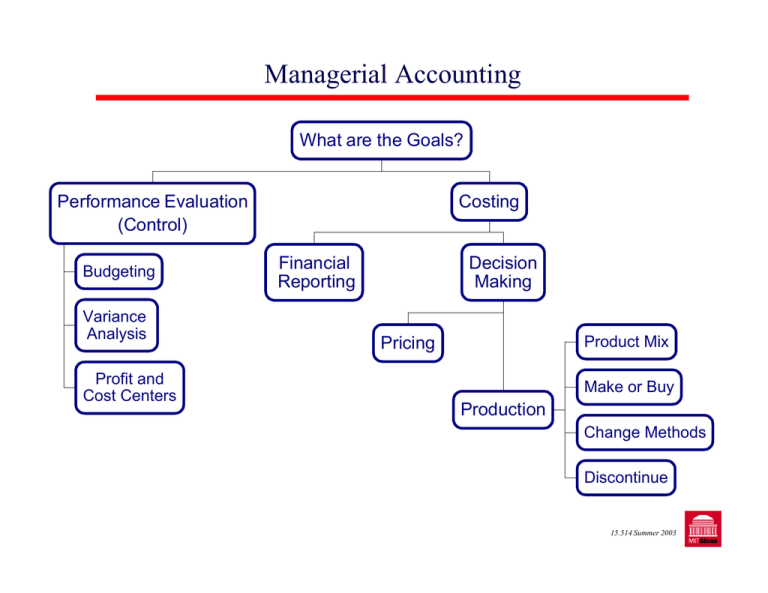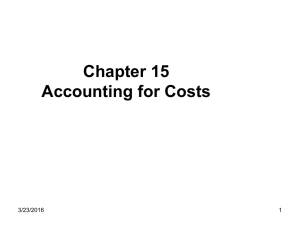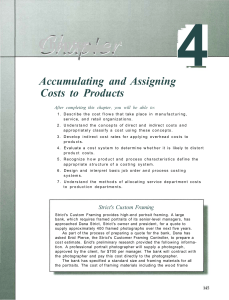Document 13615414
advertisement

Managerial Accounting What are the Goals? Performance Evaluation (Control) Budgeting Variance Analysis Profit and Cost Centers Costing Financial Reporting Decision Making Product Mix Pricing Make or Buy Production Change Methods Discontinue 15.514 Summer 2003 BASIC COST TERMS Cost A sacrifice of resources. Distinguish from “expense” Cost Object Any activity or item for which a separate measurement of costs is desired. Cost objects are the “something” in the statement: “We need the cost of ‘something’”! Cost Driver Any factor whose change “causes” a change in the total cost of a related cost object. Note: Cost drivers can be factors other than volume 15.514 Summer 2003 BASIC COST TERMS (contd.) Direct Costs Costs that can be traced to a given cost object (product, department, etc.) in an economically feasible way. Indirect Costs Costs that cannot be traced to a given cost object in an economically feasible way. These costs are also known as “overhead” or “burden.” Cost Assignment Direct costs are traced to a cost object. Indirect costs are allocated or assigned to a cost object. Product Costs All costs that “attach” to the units that are produced and are not reported as expenses until the goods are sold (e.g., direct materials, direct labor, applied overhead). 15.514 Summer 2003 BASIC COST TERMS (contd.) Period costs Costs that must be charged against income in the period incurred and cannot be inventoried (e.g., selling and administrative expenses). Manufacturing Costs The sum of direct materials, direct labor, and indirect manufacturing costs Unit Costs Total cost of units divided by units produced. Controllable Costs Any cost that is primarily subject to the influence of a given manager of a given responsibility center for a given time period. 15.514 Summer 2003 COST BEHAVIOR Variable Costs Costs that change directly in proportion to changes in the related cost driver Fixed Costs Costs that remain unchanged for a given time period regardless of changes in the related cost driver. Other Common Functions for Cost Behavior •Semivariable Costs (part variable and part fixed) •Step costs Major Assumptions Needed to Define Fixed and Variable Costs •Cost object, Time span, Linear functional form •Relevant range- the band of cost driver activity in which a specific relationship between a cost and a driver holds. 15.514 Summer 2003 The “Ins” of Inventory Accounting What costs are assigned to inventory as products are manufactured? GAAP requires Full Absorption Costing: the products fully absorb all manufacturing costs, including: Variable manufacturing Costs: Material, Labor Fixed manufacturing Costs: Overhead Results in unitizing fixed costs: convert total fixed costs (TFC) to a unit cost by allocating TFC to the units produced. 15.514 Summer 2003 Traditional Costing System Direct Costs Direct Labor Direct Materials Traced directly Product Costs Overhead Costs Indirect Labor Indirect Materials Depreciation Traced using allocation base eg direct labor hrs, machine hrs 15.514 Summer 2003 Example of Product Costing Electron, Inc. produces 10,000 units in one month. •Variable manufacturing costs are: • $6/unit for material, • $1/unit for direct labor, and • $1/unit for variable overhead. •Fixed mfg overhead is $50,000/month. •Unit costs are $8 (variable) + $50,000/10,000 (fixed) or $13/unit. •How do these costs flow through Inventory Accounts? 15.514 Summer 2003 Product Costing Events First half of November: 11/ 1: Purchase and receive $60,000 of material (Nov. supply) 11/ 2: Requisition half of the materials to the factory floor ($30,000) 11/ 5: Apply labor to the materials ($5,000) 11/ 7: Recognize depreciation expense for the month ($50,000) 11/ 8: Apply variable OH to the materials ($5,000) 11/ 9: Transfer 5,000 completed calculators from WIP to FG Inventory 11/10: Ship 2,000 completed calculators to customer 15.514 Summer 2003 How do Costs Flow through Inventory Accounts? Buy Materials Cash Raw Mat's Inv -60 60 WIP Inv Fin Goods Inv Net PP&E = Wages Payable RE = Requisition half of maerials to factory -30 30 = 5 Apply labor 5 = Apply fixed OH (PP&E depreciation) Apply variable OH 50 -50 = -5 5 = Transfer to FG inventory Sell 2,000 units -65 65 = -26 -26 = 15.514 Summer 2003 Key Strategic Management Decisions ! ! ! ! ! ! Pricing Dropping unprofitable products Re-engineering/restructuring Making new investments Mergers & acquisitions Targeting customer groups 15.514 Summer 2003 Cost Information for Strategic Decisions ! Product Costs – Pricing – Dropping unprofitable products ! Process/Business Costs – Re-engineering/restructuring – Making new investments – Mergers & acquisitions ! Customer Costs – Targeting customer groups 15.514 Summer 2003 Activity-Based Costing System Direct Costs Direct Labor Direct Materials Overhead Costs Indirect Labor Indirect Materials Depreciation Activities that drive overhd Product Costs 15.514 Summer 2003 Examples of Overhead Activities ! ! ! ! ! ! ! ! Purchase order processing Receiving/Inventorying materials Inspecting materials Processing accounts payable Facility maintenance Scheduling production Customer complaints Quality inspection/testing 15.514 Summer 2003 Typical Activity Cost Drivers ! ! ! ! ! ! ! ! ! Number of alteration notices per product Units produced Number of receipts for materials/parts Stockroom transfers Direct labor hours Set-up hours Inspection hours Facility hours Number of customer complaints 15.514 Summer 2003 ABC Example Dialglow Corporation manufactures travel clocks and watches. Overhead costs are currently allocated using direct labor hours, but the controller has recommended an activity-based costing system using the following data: Activity Level Cost Clocks Watches $120,000 10 15 Activity Production Setup Cost Driver No. of Setups Material Handling & Requisition No. of Parts 30,000 18 36 Packaging & Shipping #Units Shipped 60,000 45,000 75,000 Total Overhead $210,000 15.514 Summer 2003 ABC Example, contd. Existing Cost System: Allocate Total OH based on labor hours (35,000 hours for travel clocks; 105,000 hours for watches.) OH Rate: $210,000/140,000 hours = $1.50/hour OH cost per Travel Clock: ($1.50/hr * 35,000 hrs) / 45,000 units = $1.167 OH cost per Watch: ($1.50/hr * 105,000 hrs) / 75,000 units = $2.10 15.514 Summer 2003 ABC Example, contd. Allocation of : Production Setup Costs: Material Handl’g Costs: Packing/Shipping Costs: $120,000/(10+15) setups = $30,000/(18+36) part numbers = $60,000/(45,000+75,000) units = Resulting ABC-based Product Costs: Production Setup Material Handling Packing/Shipping Total Per Unit $4,800/setup $555.56/part no. $0.50/unit shipped Clocks $48,000 10,000 22,500 Watches $72,000 20,000 37,500 $80,500 $129,500 $1.79 $1.73 15.514 Summer 2003




